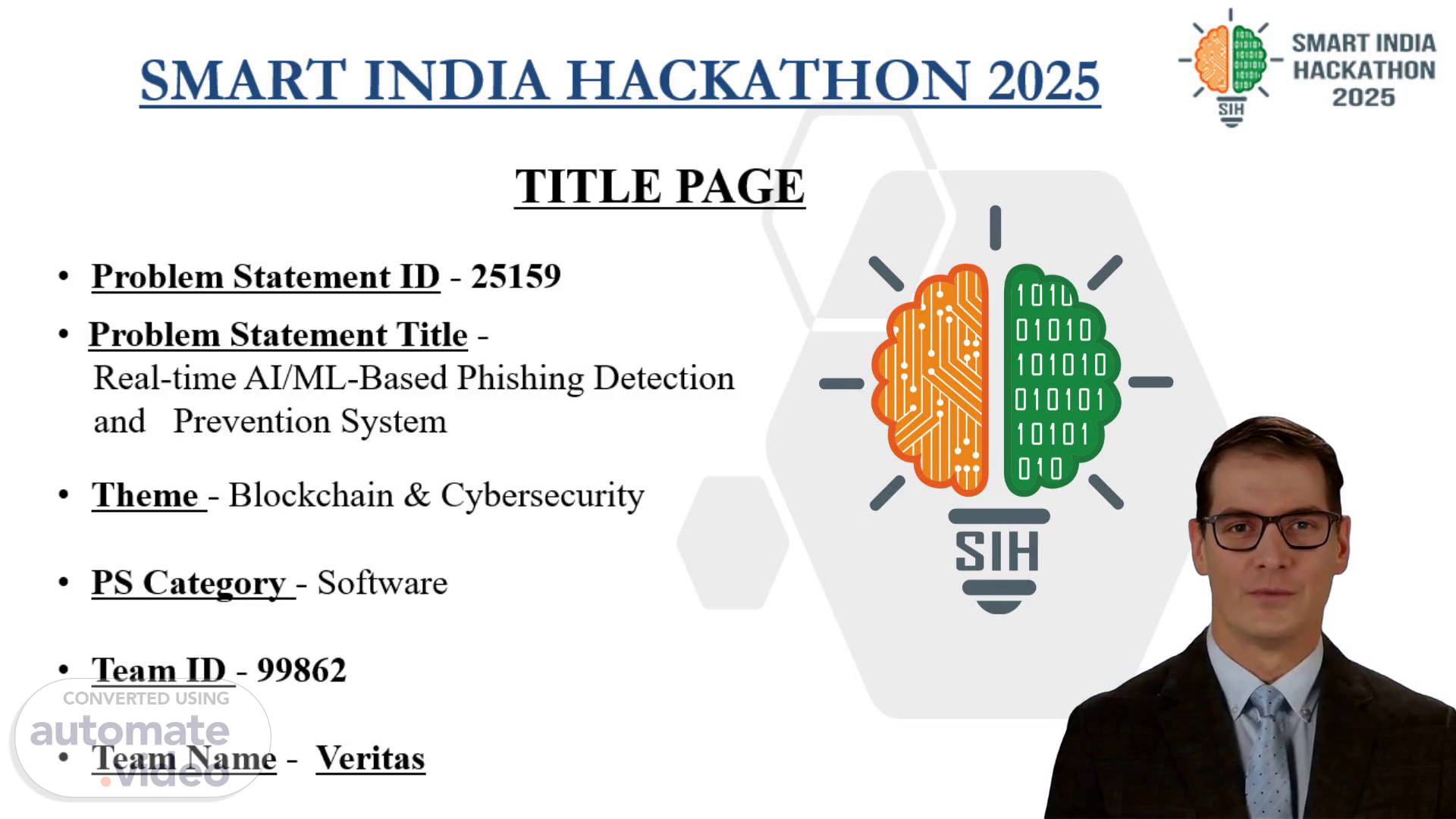Scene 1 (0s)
[Virtual Presenter] The problem statement is as follows: "The phishing attacks are a significant threat to the security of online transactions, especially for small businesses and individuals who lack advanced cybersecurity measures. The attackers use various tactics such as social engineering, spear phishing, and business email compromise (BEC) to trick victims into divulging sensitive information. These tactics often involve convincing the victim that they need to provide personal data or financial information to access a service or complete a transaction. In order to mitigate this threat, we propose a real-time AI/ML-based phishing detection and prevention system. This system will utilize blockchain technology to create an immutable record of all transactions, making it difficult for attackers to manipulate or alter records. Additionally, the system will employ machine learning algorithms to analyze patterns and anomalies in user behavior, allowing it to identify potential phishing attempts. Furthermore, the system will integrate with existing cybersecurity tools to enhance overall security posture. Our goal is to develop a comprehensive solution that can be easily integrated into existing systems, providing real-time protection against phishing attacks..
Scene 2 (1m 24s)
[Audio] The current state of cybersecurity is characterized by a lack of awareness among individuals about the risks associated with phishing attacks. Many people do not take adequate precautions to protect themselves from these types of attacks. As a result, many organizations suffer significant financial losses due to data breaches caused by phishing attacks. The majority of security solutions currently available are ineffective against these types of attacks. They rely on outdated methods such as signature-based detection and static analysis, which are no longer sufficient to detect and prevent phishing attacks..
Scene 3 (2m 5s)
[Audio] The project utilizes various key technologies including frontend and backend technologies such as JavaScript, HTML/CSS, Python, Flask, FastAPI, Docker, and Kubernetes. Machine learning and deep learning frameworks like PyTorch, TensorFlow, and Hugging Face Transformers are also employed. For text classification tasks, DistilBERT and RoBERTA models are specifically chosen for their speed and accuracy. Conventional neural networks, such as those based on the EfficientNet backbone, are used for visual processing. Graph Convolutional Networks are integrated into the domain. Furthermore, XGBoost is used for risk scoring through fusion. The combination of these diverse technologies enables the development of a sophisticated AI/ML-based system..
Scene 4 (2m 58s)
[Audio] The character of Mr. Smith was a complex one, with many contradictions. He was both a brilliant scientist and a man who loved to drink beer. He had a great deal of respect for his colleagues, but he also had a tendency to be dismissive of those who were not as skilled as him. This made it difficult for some people to work with him. However, despite these flaws, he was a kind and generous person who always tried to do what was right. His love of beer was not just about drinking, but also about sharing experiences with others. He enjoyed being around people and was often seen at social gatherings. Despite his flaws, he was a well-respected member of the scientific community..
Scene 5 (3m 44s)
[Audio] The company's social benefits include protecting users from online fraud and scams, building user trust and confidence, preventing billions of dollars in losses due to data breaches and other cyber threats, reducing security incident costs, and boosting productivity through reduced downtime and lower operational costs. Empowering users through safer digital environments also enables them to work more efficiently and effectively, which can lead to increased productivity and better outcomes. The economic impact of our solution is significant, as it prevents billions of dollars in potential losses due to cyber threats, reduces security incident costs, and boosts productivity through reduced downtime and lower operational costs. Our technical approach uses next-generation AI to detect and prevent cyber threats, including zero-day attacks, and continuously adapts to new threats through machine learning algorithms. This advanced technology ensures that our solution provides always-on, superior protection against cyber threats, transforming digital security for everyone..
Scene 6 (4m 53s)
[Audio] The AI system uses machine learning algorithms to analyze data from various sources, including social media platforms, online forums, and websites. The system can identify patterns and anomalies in this data, allowing it to detect potential phishing attempts. The AI system is trained on a large dataset of labeled examples, which enables it to learn from experience and improve its performance over time. This training process involves multiple stages, each focusing on different types of data and techniques. The first stage focuses on identifying known phishing sites and emails, while subsequent stages focus on detecting unknown or zero-day attacks. The AI system can also be fine-tuned for specific industries or domains, making it adaptable to different environments. The system's ability to analyze vast amounts of data makes it an effective tool for detecting phishing attempts, even in complex networks..
